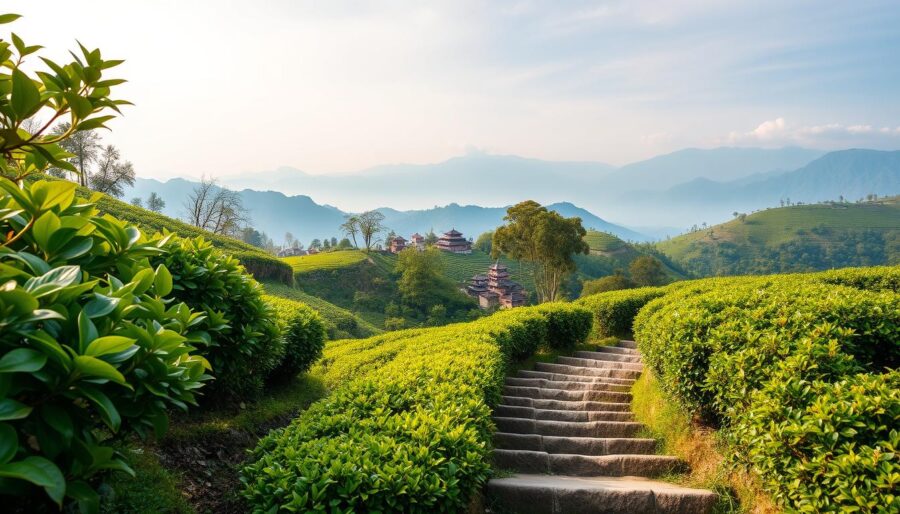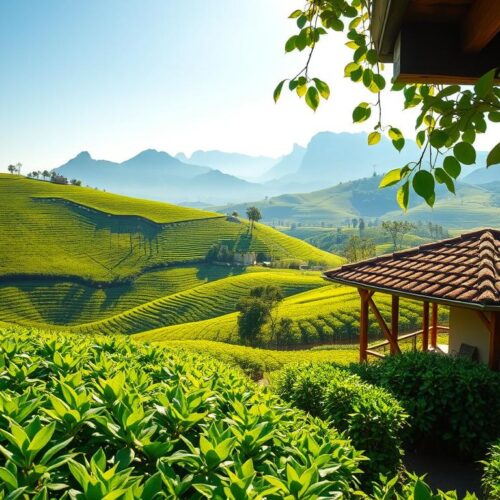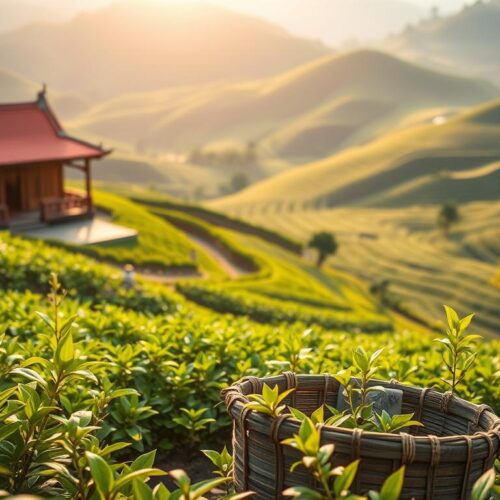Get ready to explore ancient paths where tea leaves and stories were once carried by caravans. This guide introduces you to China’s tea trails. It covers when teas are harvested, the terrain, types of tea plants, and the famous tea regions. You’ll find out why getting there early isn’t always best. In the cold, high mountains known for their history, tea buds take longer to appear. The most prized teas often come from these places. It’s true what they say: the best teas are from the deepest mountains.
Tea types in China are defined by how they’re processed and picked. This isn’t based on myths. There are green, yellow, white, Wu Long, red, and black teas. Each kind goes through processes like withering, fixing, rolling, oxidation, and roasting. Important spring dates are crucial for traditional green teas in Zhejiang and Jiangsu. This includes Longjing tea and Bi Luo Chun. You’ll learn how these timelines differ for rock oolongs and the aromatic Dan Cong teas.
Planning from the USA? Timing is key for you. The finest Wuyi and Phoenix Mountain teas come a bit later. Early spring is better for teas from Hangzhou and Suzhou. Today’s tea routes reflect the history and old tea production paths. By 2026, Hence Tea trips led by Jack Jiao will show you around Shanghai–Hangzhou–Suzhou–Yixing. It includes a retreat to Wudangshan and visits to Fuding–Wuyi Mountain–Chaozhou–Phoenix Mountain. Eastern Leaves has planned trips for 2025. These go from Shanghai–Yixing to Jingdezhen–Huangshan–Wuyishan. Then to Tongmuguan–Jianyang–Fuzhou–Kunming–Xishuangbanna–Nannuo–Laobanzhang–Yiwu. You’ll meet tea makers, visit Yixing pottery artists, see Wuyishan’s cliffs, and explore Yunnan’s ancient forests. This includes a visit to an 800-year-old tree in Nannuo and Bulang’s Laobanzhang.
You’ll get to compare Longjing tea from Hangzhou to Pu-erh tea from Xishuangbanna and Yiwu. Discover why teas from higher gardens that bud later have a richer taste. Spaces are limited. Remember to check booking and refund details. Make sure your plans match the best times to visit these regions. By the end of this guide, the path to explore China’s tea regions will be clear to you.
How China’s Historic Tea Regions Took Shape
The history of tea is like a map with distinct landmarks. Each old garden focused on perfecting a single type of tea. This dedication gave rise to famous names and trails in China that we can explore today.
In the Yangtze region, Zhejiang and Jiangsu became known for their green teas. Cities like Hangzhou and Suzhou are famous for teas that have light and sweet flavors. They ensured their tea’s quality through careful selection and precise timing.
In Fujian’s north, Wuyishan is renowned for its rock teas. These teas, like Da Hong Pao, have a unique mineral taste. Nearby Tongmuguan is famous as the birthplace of Lapsang Souchong, a type of black tea.
Guangdong’s Phoenix Mountain is famous for its Dan Cong oolongs. These teas can taste like almond, orchid, or honey, depending on the tree. In Yunnan, the focus is on Pu-erh tea, with traditions connected to ancient trade routes.
Today, we can follow these ancient tea trails with companies like Eastern Leaves. They take us through China’s tea-producing regions, from Yixing to Menghai. Hence Tea connects key locations, showing how culture and trade shaped China’s tea history.
The strength of China’s tea regions lies in their focus on one type of tea. This approach has helped create distinct and famous tea cultures. It’s a fascinating thread that connects the past with the present in the world of tea.
Reading the Land: Terroir, Climate, and Elevation
Understanding landscapes is like how farmers understand their accounts. It involves terroir, elevation, and climate. Cold air and thin soils, mixed with big temperature changes between day and night, slow plant growth. This leads to tighter plant buds and purer smells. In places like Anhui, Henan, and Jiangxi, which are far north, plants wake up late. Thus, green and yellow teas are picked in late April. Meanwhile, warmer areas like Zhejiang, Jiangsu, and some of Sichuan start harvesting weeks earlier.
Yunnan is in the south but high up, over 4,000 feet, so it’s mild even in spring. There, tea plants can be ready around the Lunar New Year. However, old-growth trees used for sheng pu’er tea get harvested later, often in March or early April. Knowing this timing is key when planning a tea journey in China.
Small differences in micro-terroir can lead to big differences in taste. Changing the direction a slope faces will alter the sunlight, leaf temperature, and growth speed. Adding different mineral soils changes how water drains and nutrients are exchanged. This affects the sap’s flow and the tea’s texture. Even two fields separated by a small path can produce teas that taste entirely different.
In Wuyishan, the core area called Zhengyan channels fog through tight valleys. This makes places under cliffs, like Yingzui, humid. The moisture climbs hourly, which cools the leaves and enriches the “rock rhyme” flavor in oolongs. Moving from sunlight into the shade of a rock, you can almost sense how the future tea will change.
Hangzhou presents another kind of balance. Its low elevation and mild climate lead to an early, soft spring. This is perfect for growing fine, delicate buds. The morning light and breezes from the lake ensure steady growth. This process creates tea with clear qualities and a sweet, nutty flavor. By observing the light and dew, you can predict the harvest time without needing a clock.
- Elevation: higher sites slow growth; expect later, more focused flavor.
- Climate: cooler latitudes delay spring; warmer coasts and basins pick first.
- Yunnan vs. Hangzhou: south–high warmth versus low–temperate balance.
- Terroir details: aspect, soils, and diurnal swings set texture and aroma.
- Canyon effects: humid corridors in Wuyishan forge the sought-after “rock rhyme.”
Cultivars and Ancient Trees: Heirlooms, Clones, and Bud Break
When you taste tea, you’re tasting its place and time. Seed-grown heirloom tea comes from deep-rooted trees with varied genetics. These ancient trees grow slowly. They react to their environment, making their first leaves appear later. Their flavors are complex and last longer. Clones, however, sprout uniformly. They yield consistent flavors which helps plantations produce steady tastes across different batches.
In Phoenix Mountain, teas are known by their names. Dan Cong is celebrated for showcasing unique flavors in each tree variety, like orchid, honey, or almond. This difference is rooted in when they bloom. For example, Bai Ye blooms 15–20 days before Ba Xian in the same area. This timing affects when teas are available and can make later harvests more expensive.
Yunnan operates on its own schedule. The region’s prized ancient trees, known as Gu Shu, start growing leaves later than younger trees and plantation clones. You won’t often find true Gu Shu in early-spring markets. Knowing when each type of tree blooms helps you visit at the best time for tasting.
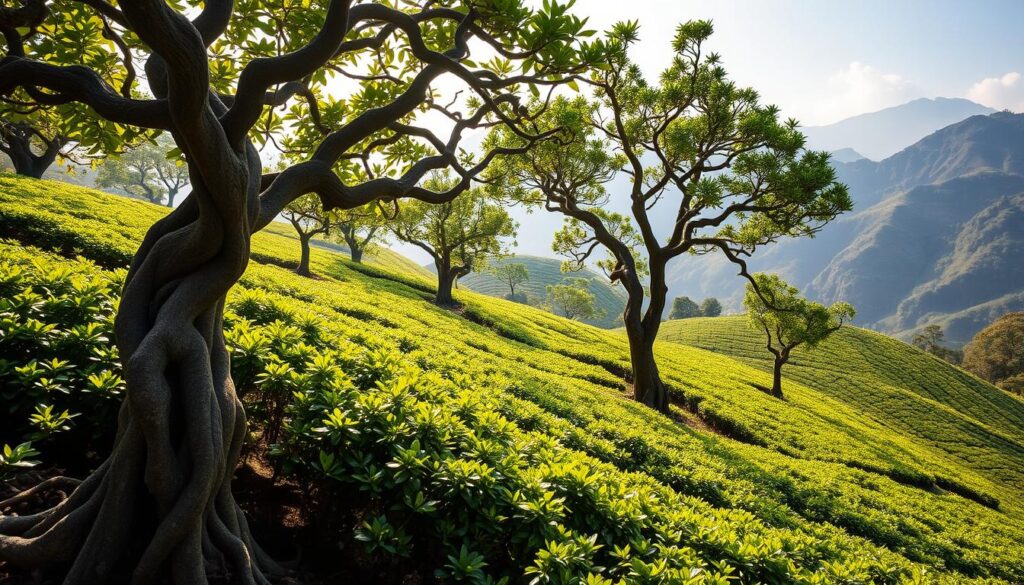
| Type | Propagation | Typical Bud Break | Flavor Profile | Examples/Regions | Buyer Insight |
|---|---|---|---|---|---|
| Heirloom Tea Trees | Seed-propagated | Later, variable year to year | Layered, site-driven, long finish | Old groves in Fenghuang and Yunnan | Arrive later in spring; pay for authenticity and depth |
| Clones | Asexual cuttings | Earlier, uniform across fields | Consistent, focused, repeatable | Large plantations in Zhejiang, Fujian, Yunnan | Reliable scheduling and pricing; steady house profiles |
| Dan Cong Single-Cultivar | Asexual, tree-specific lines | Staggered by cultivar | Aromatic signatures (orchid, honey, almond) | Phoenix Mountain (Fenghuang) | Track Bai Ye (early) vs Ba Xian (late) for availability and price |
| Yunnan Gu Shu | Seed-grown, ancient trees | Late spring emergence | Thick texture, deep sweetness, long aftertaste | Xishuangbanna, Lincang, Pu’er | Rare in early markets; peak cups after mid-spring |
| Smallholder Young Trees | Seed or young clonal stock | Mid-spring | Bright, brisk, clear aromatics | Village plots across Yunnan | Good value when Gu Shu is not yet available |
- Map your stops to cultivar timing to catch peak aromatics.
- In Fenghuang, expect Bai Ye first; budget later for Ba Xian.
- For Yunnan, plan Gu Shu tastings after early spring fairs.
Harvest Rhythms and Processing Styles Across China
Harvesting differs by tea type, not just by tender quality. Green tea starts with one bud and one leaf. Yellow tea prefers a single bud, and white tea does too. Oolong, or Wu Long, waits until the leaves open up. Red tea has one bud and two leaves, and black tea uses fuller leaves with stems.
Historic tea mountains usually stick to one type of tea. In places like Hangzhou and Wuyishan, each bush gives only one kind of tea. This affects how the tea tastes and helps you know when to visit China’s tea areas.
Spring comes early by the coast. Fuding is first with white tea, while colder areas start with green and yellow teas in late April. Oolong areas, like Wuyishan, begin in May. There, careful roasting extends the tea season until winter.
Dan Cong tea from Guangdong has its own schedule. It hits the market in summer, after a rest period. Red tea release times differ. Yunnan’s Dian Hong may come first, while Tongmuguan’s Zhengshan Xiaozhong waits until late May, after Wuyi oolong.
Plan your tea travels with these times in mind. Start with fresh Ming Qian Longjing in Hangzhou. Then, go back for Wuyi rock oolongs after their processing. This way, you can experience the immediate taste of green tea and the deeper flavors of oolongs and red teas from different areas.
| Category | Baseline Picking Standard | Typical First Releases | Regional Notes |
|---|---|---|---|
| Green Tea | One bud / one leaf | Late March to late April | Hangzhou focuses on early Ming Qian batches for vivid aroma and snap. |
| Yellow | Single bud | Late April | Colder zones start later; sealed “menhuang” steps demand precise timing. |
| White | Single bud | Early spring | Fuding leads the season with light withers and gentle sun-drying. |
| Oolong | Open-face leaves | May to summer | Wuyishan harvests in May; roast refinement extends releases into winter. |
| Red Tea | One bud / two leaves | Varies by origin | Yunnan’s Dian Hong is early; Tongmuguan’s Zhengshan Xiaozhong can be late. |
| Black | Leaves and stems | Mid to late season | Heavier leaf grades support full oxidation and layered body. |
Map out your tea year in China with this guide. Start with early white teas, then move to green tea when its buds are just right. Switch to oolong when the leaves spread and roasting is done. End with red tea, according to local schedules. This way, you’ll taste China’s seasonal cycle in every cup.
Longjing in Hangzhou and the Meaning of Chun Fen, Qing Ming, Gu Yu
Visiting Hangzhou for Longjing tea means timing is key. Chun Fen, around March 20, is the middle of spring but not for harvesting. It starts the season for picking the first heirloom buds in Zhejiang and Jiangsu, especially in West Lake’s classic groves.
To taste delicate heirloom Longjing, plan your visits from Chun Fen to Qing Ming. “Ming Qian” teas are picked before Qing Ming from old trees. By Qing Ming, clone plants may have peaked, but heirloom fields look vibrant. Light rains during this time make Longjing tea finer and add a nutty aroma.
Gu Yu, around April 20, marks the latest time for “Yu Qian” teas, known for their full flavor. Just before Gu Yu, cooler areas start their green and yellow tea seasons. But in Hangzhou, the focus is on the balance and sweetness of pan-fired Longjing.
Remember, these dates are specific to heirloom green tea in Zhejiang and Jiangsu. They don’t apply to oolong or Pu-erh, nor do they dictate white tea timing in Fuding. When exploring China’s tea landscape, use these Hangzhou dates for heritage versus clone comparisons, not for other regions.
- Best window in Hangzhou: Chun Fen to Qing Ming for heirloom clarity.
- Expect earlier clone flushes; sample side by side to feel the shift.
- Yu Qian near Gu Yu brings rounder body and lasting finish.
- Apply these markers only to Zhejiang/Jiangsu heirloom green tea on the China tea trail.
| Date Marker | Typical Window | What to Seek in Hangzhou | Notes on Scope |
|---|---|---|---|
| Chun Fen | ~March 20 | Earliest heirloom buds; airy aroma, pale liquor | Season divider, not a fixed harvest day |
| Qing Ming | April 4–6 | Ming Qian heirloom Longjing tea with soft chestnut notes | Clone lots often past peak by this point |
| Gu Yu | ~April 20 | Yu Qian teas with more depth and savory length | Coincides with cooler-region green/yellow starts |
Start by booking visits to farms near Longjing Village and Meijiawu before Qing Ming. This is when the buds start to appear. Then, come back close to Gu Yu to see how the tea changes. This way, your Hangzhou journey captures the most important dates for Longjing tea.
Pu-erh in Yunnan: From Xishuangbanna Forests to Ancient Tea Horse Road
In Yunnan, where the land meets sky, flavors blend uniquely. Even high up, it’s warm enough for tea bushes in Xishuangbanna to bud early. They may start growing around Chinese New Year. True old-tree Pu-erh, though, tends to sprout by Qing Ming, but that’s just timing, not planned.
By March and April, you rarely find real ancient-tree tea in markets. These old trees take their time, growing slowly in the shade. Their roots reach deep into a blend of red soil and limestone. This impacts the price, scent, and the care in sorting leaves by their age and growth height.
Eastern Leaves offers a dive into tea’s rich history. In Kunming, Li Haibo teaches you the art of gongfucha. You learn how to perfectly pour tea, considering the water’s heat and the shape of the pot. In Menghai, you get to explore different teas. You’ll experience the difference between wet-piled shu and airy sheng. Then, you’ll learn how each tea relates to where and when it was picked.
On Nannuo Mountain, an 800-year-old tree is your guide. You listen to cicadas as the taste of resin and wildflower unfolds from your cup. In Bulang, you visit places known for their unique teas. Each location shows how locals protect their trees and influence tea prices.
Towards the east is Yiwu, a place rich in trade history. You’ll find yourself wandering from one historic spot to another, each area offering a distinct taste. In these places, each sip of Pu-erh tells the story of a journey through Yunnan.
You’ll also meet Mr. Hu, who led a long trek from Pu’er to Beijing in 2005. His story brings the Ancient Tea Horse Road to life. It connects old trade routes to the tea we enjoy today. Through his story, you see how nature, hard work, and history blend into each cup.
Wu Yi Shan Rock Oolongs and Phoenix Mountain Dan Cong
You’ll experience two types of expertise. One from the cliff territories of Wu Yi Shan, and the other from Phoenix Mountain’s floral touch. Wuyi Mountain shelters Zhengyan gardens under its rugged landscape, which crafts oolong with a hint of minerals and a consistent sweetness. The leaves are picked in early May, but the roasting that follows can extend to November. This means the best Yancha usually comes to markets in the fall.
When planning your visit, consider both the place and the time. If you visit in spring, you’ll likely only get to see the newly picked leaves. Most of the processed tea is ready by November or December. But if you visit Wu Yi Shan later, you can taste fully roasted teas like Da Hong Pao and Shui Xian. They each offer a unique taste of the area. Near Jiuqu River, following its path to Tongmuguan can show you the history of red tea and map out today’s oolong varieties.
Getting the right access is crucial. With the guidance of Eastern Leaves and farmer-guide Pengbao near Yingzui peak, you’re in for a treat. You get to explore different parts of the park, see how the teas change over small distances, and taste how elements like shade and wind affect the flavor. Here, “true cliff” becomes more than just a term—it’s an experience you can identify by taste alone.
In Fenghuang Shan, Guangdong, the focus is on Dan Cong teas made from single tea plant types. For example, Bai Ye usually blooms earlier than Ba Xian in the same area, and teas from later crops often sell for more. Since these teas are picked and processed in stages, the best Dan Cong teas arrive in summer.
Mark your calendar for when each tea is best. For Wuyi Mountain, aim for fall and winter when the Yancha is at its best. For Phoenix Mountain, late spring and summer are the times for fresh Dan Cong. In both places, trying small batches is key. This involves brewing the tea for a short time, using high heat, and paying attention to the aftertaste to understand where it came from.
- Wuyi Mountain (Wu Yi Shan): Early May harvest; extended roasting; peak market presence November–December; mineral, spiced oolong.
- Phoenix Mountain (Fenghuang Shan): Staggered harvests; Bai Ye earlier than Ba Xian; summer arrivals; aromatic, single-cultivar Dan Cong.
- Field Notes: Observe micro-climates under Yingzui; follow the Jiuqu River toward Tongmuguan for historical context and route planning.
| Region | Signature Focus | Harvest & Release | What You Taste | Best Visit Window |
|---|---|---|---|---|
| Wuyi Mountain (Wu Yi Shan) | Zhengyan rock oolong | Harvest early May; roasting through Nov; peak sales Nov–Dec | Mineral “yan yun,” spice, dried fruit, long finish | Late fall to winter for finished Yancha |
| Phoenix Mountain | Dan Cong single-cultivar | Staggered; Bai Ye earlier than Ba Xian; summer releases | Orchid, honey, stone fruit, shifting aromatics per cultivar | Late spring to summer for new Dan Cong |
For a great trip, visit Wuyishan after spring to try the fully processed oolong. Then, move to Chaozhou for Phoenix Mountain’s early summer offerings of Dan Cong. This way, your journey follows both the calendar and the landscapes that shape these teas.
White and Red Tea Corridors: Fuding, Tongmuguan, and Beyond
You can follow spring by tasting teas along Fujian’s ancient paths. In Fuding, the hunt for white tea is best as buds grow in cool sea air. Baihao Yinzhen tea starts from mid to late March, soon followed by Bai Mudan, which needs one bud and two leaves. Here, tea makers watch the fields instead of the calendar, ignoring the traditional Qing Ming and Gu Yu dates.
In Wuyishan’s area, you find Tongmuguan, the cradle of red tea. Zhengshan Xiaozhong tells the tale of the village, from pine-smoked to pure, unsmoked varieties. Eastern Leaves offers tastings that show off the tea’s differences, including smoked batches by Wu Chongfa. The original spot on the Jiuqu River lets you explore the origins of hongcha.
Red tea seasons stretch across many places. Dian Hong from Yunnan might come first, while Tongmuguan’s Zhengshan Xiaozhong is available even after Wuyi oolongs end in late May. This timeline lets you enjoy a journey from early white teas in Fuding to late-spring hongcha smoothly.
Jianyang brings a special touch to this path. Jianzhan ware from the Song dynasty, which was used with whisked tea, now enhances the look and feel of yancha and hongcha. The ware’s thick glaze keeps the tea hot, enhancing the malt and pine flavors of Zhengshan Xiaozhong and the light florals of fresh white tea.
Travel cue: Start in Fuding late in March for the best teas, then move to Tongmuguan as spring progresses. Look forward to authentic Wuyi oolong later, but focus on white and red teas during this period.
- Fuding: Baihao Yinzhen mid–late March; Bai Mudan follows as weather warms.
- Tongmuguan: birthplace of red tea; explore Zhengshan Xiaozhong styles, smoked and unsmoked.
- Seasonality: Yunnan Dian Hong often appears first; Wuyi oolong releases lag behind hongcha.
- Craft touchpoints: tastings with Eastern Leaves; smoked lots by Wu Chongfa; Jiuqu River heritage.
- Teaware note: Jianzhan cups emphasize body and hue for both white tea and red tea.
tea trail China: Planning Your Route Through Regions and Seasons
Plan your China tea trail by following the harvest. Don’t stick to a set schedule. Craft a journey that brings you to each tea at its best moment. You’ll also get to learn from those who make the tea.
Visit Hangzhou from March to early April. You’ll experience Longjing tea at its prime. Try pairing tea tastes with visits to kilns in Suzhou and Yixing. Hence Tea offers a tour from March 26 to April 7, 2026, covering these places. It’s your choice between an 8- or 11-day trip, with a max of 7 people.
In mid to late April, head east for white teas in Fuding. End April is perfect for Anhui’s teas. Don’t miss cultural sites in Jingdezhen and Huangshan, like the Songluo Tea Culture Museum.
Early to mid-May is for Wuyishan. Here, you catch the making of Zhengyan yancha. The best time to taste it might be later, around November or December. Make plans to return for this.
Summer is for Phoenix Mountain Dan Cong in Chaozhou. Hence Tea has a program from April 16 to 26, 2026, for an in-depth experience.
For Pu-erh, focus on Yunnan, near Kunming and Xishuangbanna. Eastern Leaves offers seminars and field trips here. Plan to see the Gu Shu harvest.
Keep your travel plans simple. Stick to small groups, usually no more than 7. Deposits are $1,000, with refunds varying by how early you cancel. An early deposit might get you a special gift, like a Chaozhou gaiwan set.
For tours over 14 days, you’ll need a visa. It can take 3–10 business days. The China Visa Application Center can help. Time your trip with tea release cycles to taste each tea at its best.
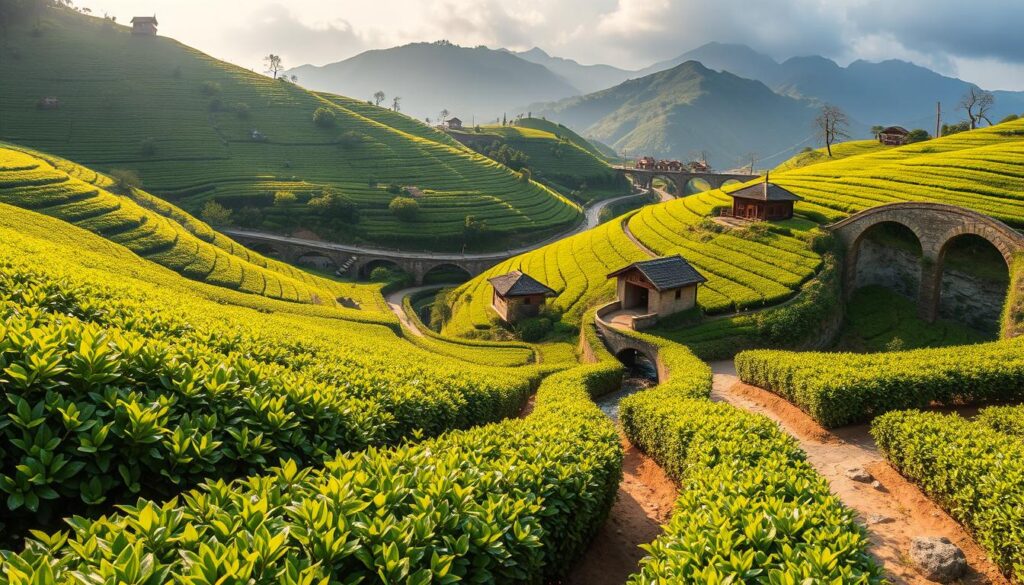
| Window | Regions & Focus | Key Teas | Programs & Notes | Booking & Practical Tips |
|---|---|---|---|---|
| Mar–Early Apr | Hangzhou, Suzhou, Yixing | Longjing (Chun Fen–Qing Ming–Gu Yu) | Hence Tea Program 1: Shanghai–Hangzhou–Suzhou–Yixing; Taizhou optional; 8- or 11-day; max 7 guests | $1,000 deposit; tiered refunds; early-deposit welcome kit (Chaozhou gaiwan set) |
| Mid–Late Apr | Fuding; Anhui (Lu’an, Huangshan) | Baihao Yinzhen, Bai Mudan; Lu An Gua Pian, Huangshan Maofeng | Jingdezhen ceramics; Songluo Tea Culture Museum in Huangshan | Build buffer days for rain; confirm factory access during peak sorting |
| Early–Mid May | Wuyishan | Zhengyan yancha (rock oolong) observation | Harvest/roast viewing; releases often Nov–Dec after refining | Plan follow-up tastings; ship samples when lots are finalized |
| Late Spring–Summer | Chaozhou, Phoenix Mountain | Dan Cong single-fragrance oolongs | Hence Tea Program 3: Fuding–Wuyi–Chaozhou–Phoenix Mountain | Reserve cupping labs early; heat and humidity affect travel times |
| Spring–Early Summer | Yunnan: Kunming, Xishuangbanna, Menghai, Yiwu | Pu-erh: Gu Shu from Nannuo, Bulang (Laobanzhang, Laoman’e, Hekai) | Eastern Leaves seminars in Kunming; field visits tied to picking | Confirm mountain permits; expect variable road conditions after rain |
| Admin Timeline | Visa & Logistics | — | China Visa Application Center processing 3–10 business days | Match itinerary to release cycles; keep group size to 7 for agility |
- Map your China tea trail around harvest peaks, not fixed dates.
- Use Hangzhou and Yunnan as anchors, then stitch regions by release windows.
- Time purchases to when lots clear refining and quality control.
Culture in Every Cup: Teaware, Ritual, and Local Life
You step into the world of Chinese tea culture through touch, warmth, and the act of breathing. In Yixing, you hold the famed purple clay from Mine No. 4 in your hands. You see the dragon kilns come alive with flame. Artists Yuan Weixin and Lian Meiping share insights on why certain teapots are best for specific teas. You learn how the special zisha clay controls the tea’s flow and temperature.
In Jingdezhen, the journey takes you past old imperial kilns. These places connect you to a history that began in the Tang Dynasty. The area’s unique kaolin clay and waterways explain its long history with the imperial court. You discover how the porcelain’s quality enhances your tea experience, especially with delicate green and white teas.
Jianyang is home to the famous Jianzhan, also known as Tenmoku tea bowls. You get to compare ancient designs with those made by current masters. After trying your hand at glazing, you test how the bowl holds heat. The design even affects the tea’s aroma and color, adding depth to your experience.
In Kunming, expert Li Haibo introduces you to the nuances of gongfucha. You explore how different Yixing pots affect tea flavors. You notice how each teapot’s shape and clay composition extract unique tastes. Through practice, you learn to match your teaware to the tea, enhancing each cup’s quality.
Xishuangbanna unveils the ancient art of making incense. You explore various blends of resin and herbs. These incense recipes enhance the tea experience without overpowering it. Learning when to light the incense adds calm to the room, making each cup more enjoyable.
You see how local life enriches the tea culture on Nannuo mountain. Hani villagers cook with bamboo shoots and wild greens, right beside fresh tea. In places like Laoman’e, the sound of temple bells creates a peaceful backdrop. In Fujian, courtyard meals accompany slow-brewed Wuyi yancha. Yiwu’s stone paths remind you of the old tea horse trade.
Today, companies like Hence Tea focus on wellness and deep cultural immersion. They encourage you to slow down and appreciate every step of the tea ritual. Your journey connects tradition with personal experience, making every cup a reflection of both history and place.
- Core mediums: Yixing zisha for structure; Jingdezhen porcelain for clarity; Jianzhan for heat and visual depth.
- Key practices: gongfucha timing, water control, and pairing teaware to leaf shape and roast.
- Regional cadence: Chaozhou quick infusions; Fujian courtyard hospitality; Yunnan incense lines with pu’er.
As you explore, you gather a unique set of tools—teaware that shows respect for the tea leaf, methods that honor tradition, and little rituals that bring Chinese tea culture to life in your own hands.
Conclusion
You leave with a map and clock for timing. In Hangzhou, seek out family-made Longjing tea around Chun Fen to Qing Ming, then stop. Spring starts with Fuding white teas. Wu Yi Shan rock oolongs and Phoenix Mountain Dan Cong come next. In Yunnan, notice the cycle: original Gu Shu teas show up after cloned ones, and Pu-erh tea tastes better if you’re patient and pick wisely.
Use standards to check if a tea is real and ready. Historic places usually stick to one tea type, so understand the area first, not just what’s written on the package. The land’s height, the tea plant variety, and the weather tell you when and what teas will taste best. This helps you find your own path through China’s teas, following nature, not hopes.
If you want help exploring, plan your trips with experts. Hence Tea has trips till 2026 covering Shanghai to Hangzhou to Suzhou to Yixing, a retreat in Wudangshan, and a journey from Fuding to Wuyi to Chaozhou to Phoenix Mountain. Eastern Leaves runs immersive tours to Yixing, Jingdezhen, Wuyishan, Tongmuguan, and several spots in Yunnan like Nannuo and Yiwu. Sign up early, sort out your visa well in advance, and schedule your tastings for when the teas are truly at their best—months after they are picked for Wuyi Yancha and into summer for the real Dan Cong.
Understanding the land, the tea plants, and the climate helps you make your personal tea journey in China. You’ll get to enjoy Longjing tea when it’s finest, wait for Pu-erh from ancient trees, and discover later-season oolongs that share their fiery and rocky flavors. By following the natural tea cycle in China, every cup tells a story of the country’s past.

